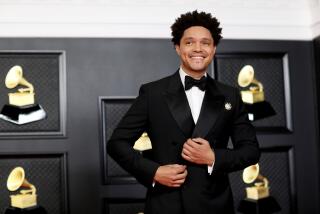A New Effort Under Way to Define Violence on TV : Studies: Two projects will look at all programming except news. Their findings may influence future regulation.
- Share via
As the fall season unfurls over the next few weeks, banks of newly installed videotape machines located in university halls will be quietly taping almost everything TV has to offer.
In the coming months, college students in Los Angeles, Santa Barbara and Austin, Tex., will be paid to pore over those videotapes and check them twice, marking down everything that’s naughty and nice.
Specifically, they will be looking for acts of violence. Future regulation of the TV industry may be determined by what they find.
These students and the experienced researchers in charge of them are the nation’s new violence monitors. They will be working for two separate nonprofit organizations, Studio City-based Mediascope and the UCLA Center for Communication Policy, that have been retained by the TV industry to define violence and tally the amount of it on the tube over the next three years.
The studies were commissioned in response to a challenge--or threat, depending on your perspective--issued last year by Sen. Paul Simon (D-Ill.), who has been spearheading a move in Congress to reduce TV mayhem. He called for the formation of an independent “advisory office” to devise a uniform set of standards for TV violence, then act as a strict monitor to let the public know just how well the industry meets those standards.
If Simon’s proposal was heeded, he vowed, he would do his best to keep the hounds at bay in Congress. If the TV industry did not cooperate, Simon said, he would let the lawmakers loose on Hollywood.
“What I want is to keep pressure on--but to keep pressure on not from the government, but from the public, if you will,” Simon said in a recent phone interview. “I want to make sure that what we’re going through really is an evolutionary process that will continue in a constructive direction, and not wind up as a bone tossed out to those of us in government who are concerned, before they (television executives) go back to their old ways.”
The broadcast and cable TV industries could have satisfied Simon by choosing a single monitor. But broadcast and cable executives have been adversaries for years, and each selected its own independent monitor.
The National Cable Television Assn. will pay $3.3 million for the three-year study to Mediascope, a nonprofit organization created in 1992 with the mission of helping Hollywood present violence in a more socially responsible way. Mediascope will work with the universities of California at Santa Barbara, Texas at Austin, Wisconsin at Madigan and North Carolina at Chapel Hill to coordinate a study of a composite week of TV programming from early morning through late night.
ABC, CBS, NBC and Fox, meanwhile, together will pay $500,000 a year to the UCLA Center for Communication Policy, which was formed last year to address the rapidly changing communications developments that are transforming society. The center will focus primarily on prime-time and children’s programming, examining specific programs and time slots several times over the course of each season.
Both studies will include broadcast and cable programming to capture a full picture of the landscape. Both will define media violence and then analyze the context in which violence occurs in TV programs--taking into account such factors as whether the violent act is rewarded, how graphically the violence is portrayed and whether children are likely to be watching.
*
“We know that if a very young child sees a violent act take place, and they see no negative consequence of that act, that child will see that the violent act was rewarded,” Mediascope President Marcy Kelly said. “Now, if you see a violent act in the beginning of a two-hour movie and it was not punished for two hours, a very young child does not see the consequences. Clearly there are stories perfectly appropriate for an adult, but if you’re marketing the same story for a 5-year-old, that becomes a problem.”
Jeff Cole, director of the UCLA center, said his group is also operating on the assumption that “violence itself is not necessarily evil. It depends on how it is used.”
“Most studies simply count violent acts,” he said, “and all acts are lumped together with nothing to distinguish either the context in which the violence occurs or whether the violence is appropriate or justified. Under that system, a pinch is fairly equated with a decapitation.”
According to one study, Cole continued, “the most violent show on television last year was a ‘Laugh-In’ retrospective. The problem with those systems, if you are a network and you want to be responsible, (is that) you have to remove the violence without considering the context or plot. There would be nothing to distinguish between the violence in ‘The Lion King’ and ‘I Spit on Your Grave.’ ”
The first findings of the two studies will be published next year and will be available to the public.
In both the monitoring efforts, the first line of screeners will be college students. They are now being trained to identify problematic programming--in Los Angeles for the UCLA study, and in Santa Barbara and Austin for Mediascope.
Based on the definition of TV violence that Cole is still working on, the students at UCLA will rate what they watch one of three ways: needs no review by supervisors, may need review or definitely needs review.
“Students can’t independently declare programming problematic,” said Cole, who has taught communications at UCLA for 19 years. “Anything that needs review will be brought to a larger meeting of the senior staff.”
Beginning with the taping of the new Fox lineup Sunday night, the UCLA team will review virtually every program that airs in prime time on the four broadcast networks--made-for-TV movies, theatrical movies, comedy and drama series--and TV programs directed at children throughout the day. Each regularly scheduled program will be looked at a minimum of four times.
*
UCLA will also examine advertising and promotional spots on the networks; some critics complain that TV commercials for violent movies playing in theaters are worse than any programs produced specifically for television. There will also be a two-week-sample study of programming for public broadcasting, prime-time syndication and the cable networks, and also of the top 10 video rental titles for each quarter and the top five video games each year. News programming will be excluded.
In some ways, the Mediascope study will be even larger--an exhaustive analysis of 25 cable and broadcast channels from 6 a.m. to 11 p.m., or more than 2,700 hours total of programming.
“What we’re trying to do is look at a week in the life of television,” Mediascope’s Kelly said, although it won’t be a week in the calendar sense but rather a composite of programs taken from different times during the season.
In addition to a thorough content analysis of programming that will focus on violence in its complete context, an array of other studies will be conducted at the four participating universities. These will examine how viewers understand, interpret and respond to violence advisories and ratings systems. They will analyze the effectiveness of violence prevention efforts, educational activities and public-service announcements. They will look at the TV industry’s scheduling practices.
Unlike the UCLA effort, the Mediascope study will include representatives of the entertainment industry in the research and design stage. Researchers have been working all summer to develop a coding scheme to create definitions for different categories of violence. Next weekend, the researchers will meet with TV executives and producers at the University of Texas in Austin to present their preliminary designs and get feedback. Five more meetings are being scheduled for Los Angeles to focus on separate program forms such as children’s animation and dramatic programming.
“We want their voices to be heard, so the final product does not just reflect an academic point of view but also reflects the entertainment industry,” Kelly said.
Martin Franks, CBS senior vice president and spokesman for the broadcast networks on the violence issue, said he and his peers looked over Mediascope’s proposal and were impressed by it but that they simply liked UCLA’s better.
“We just wanted to do something different,” Franks said. “Who’s to say two voices aren’t better than one? We think we may learn from theirs, and they may learn from ours.”
“I wish there was just one monitoring group. Then we’d have some uniform standards to use for evaluating all of this programming,” said Rep. Edward J. Markey (D-Mass.), chairman of the telecommunications subcommittee of the House Energy and Commerce Committee. Markey is still pushing for his own solution to TV violence in the form of a “V chip” inside the TV set that would filter out troublesome programming.
“Two monitoring groups could result in confusion for parents, because there will be different reports coming from different sources simultaneously,” he said. “Our highest priority should be to give simple information to parents, so they can protect their children.”
* V-CHIP BILL: A legislator presses for a computer chip to block violent programs. F17
More to Read
The complete guide to home viewing
Get Screen Gab for everything about the TV shows and streaming movies everyone’s talking about.
You may occasionally receive promotional content from the Los Angeles Times.






